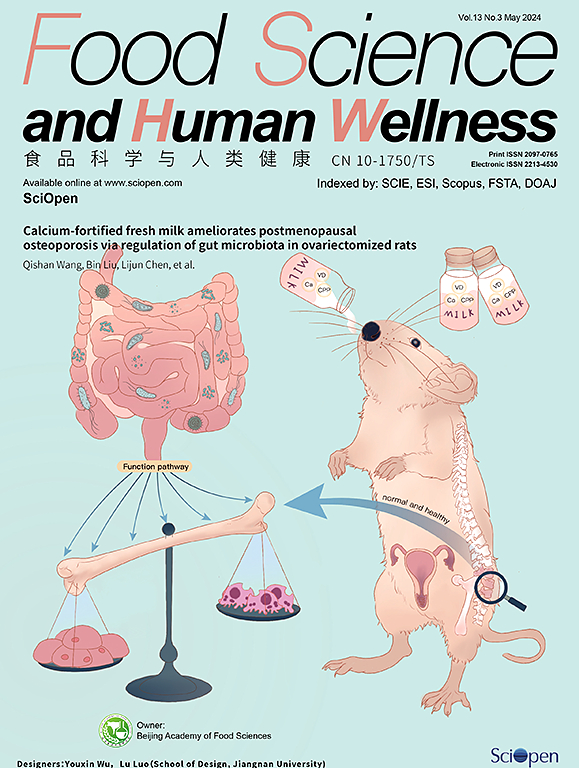Dietary (poly)phenol intake is associated with cardiometabolic health parameters in adolescents
IF 7.4
1区 农林科学
Q1 FOOD SCIENCE & TECHNOLOGY
引用次数: 0
Abstract
The protective role of (poly)phenols against metabolic disorders has been extensively studied in adults but not in adolescents. To assess associations of dietary (poly)phenols and their subclasses with cardiometabolic health parameters in adolescents. A cross-sectional study was conducted in 944 individuals aged 11–14 years enrolled in the SI! Program for Secondary Schools trial (NCT03504059). (Poly)phenol intake was assessed using semi-quantitative food frequency questionnaires and the Phenol-Explorer database. The measured cardiometabolic parameters were waist circumference (WC) age-sex Z-score, blood pressure (BP) age-sex Z-score, blood glucose (BG), triglycerides (TG), and high-density lipoprotein cholesterol (HDL-c). Multilevel mixed-effect linear regression models were applied to examine the association between (poly)phenol quintiles and cardiometabolic health parameters. Compared to the lowest quintile, adolescents in the highest quintile of total (poly)phenol intake had lower WC Z-scores, mean arterial pressure Z-scores, and HDL-c after multivariable adjustment. The WC Z-scores and HDL-c were lower in the highest quintile of flavonoid intake compared to the lowest quintile. The highest quintile of phenolic acid intake was associated with a lower WC Z-score and TG levels, and the highest quintile of stilbene intake with lower BG and TG, and with higher HDL-c compared to the lowest quintile. A higher intake of (poly)phenols, especially flavonoids, phenolic acids, and stilbenes, was associated with better cardiometabolic parameters in adolescents.
膳食(多)酚摄入量与青少年心脏代谢健康参数有关
(多)酚对代谢紊乱的保护作用已在成人中广泛研究,但在青少年中尚未研究。评估青少年饮食(多)酚及其亚类与心脏代谢健康参数的关系。一项横断面研究对944名11-14岁的SI!中学项目试验(NCT03504059)。采用半定量食物频率问卷和酚- explorer数据库评估多酚摄入量。测量的心脏代谢参数为腰围(WC)、年龄-性别Z-score、血压(BP)、年龄-性别Z-score、血糖(BG)、甘油三酯(TG)、高密度脂蛋白胆固醇(HDL-c)。采用多水平混合效应线性回归模型检验(多)酚五分位数与心脏代谢健康参数之间的关系。与最低的五分位数相比,总(多)酚摄入量最高的五分位数的青少年在多变量调整后的WC z评分、平均动脉压z评分和HDL-c均较低。在类黄酮摄入量最高的五分位数中,WC - z分数和HDL-c低于最低的五分位数。与最低五分位数相比,酚酸摄入量最高的五分位数与较低的WC - z评分和TG水平相关,而苯乙烯摄入量最高的五分位数与较低的BG和TG以及较高的HDL-c水平相关。青少年摄入较多的(多)酚类物质,特别是类黄酮、酚酸和二苯乙烯,与较好的心脏代谢参数有关。
本文章由计算机程序翻译,如有差异,请以英文原文为准。
求助全文
约1分钟内获得全文
求助全文
来源期刊

Food Science and Human Wellness
Agricultural and Biological Sciences-Food Science
CiteScore
8.30
自引率
5.70%
发文量
80
审稿时长
28 days
期刊介绍:
Food Science and Human Wellness is an international peer-reviewed journal that provides a forum for the dissemination of the latest scientific results in food science, nutriology, immunology and cross-field research. Articles must present information that is novel, has high impact and interest, and is of high scientific quality. By their effort, it has been developed to promote the public awareness on diet, advocate healthy diet, reduce the harm caused by unreasonable dietary habit, and directs healthy food development for food industrial producers.
 求助内容:
求助内容: 应助结果提醒方式:
应助结果提醒方式:


